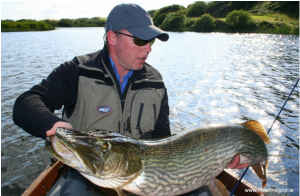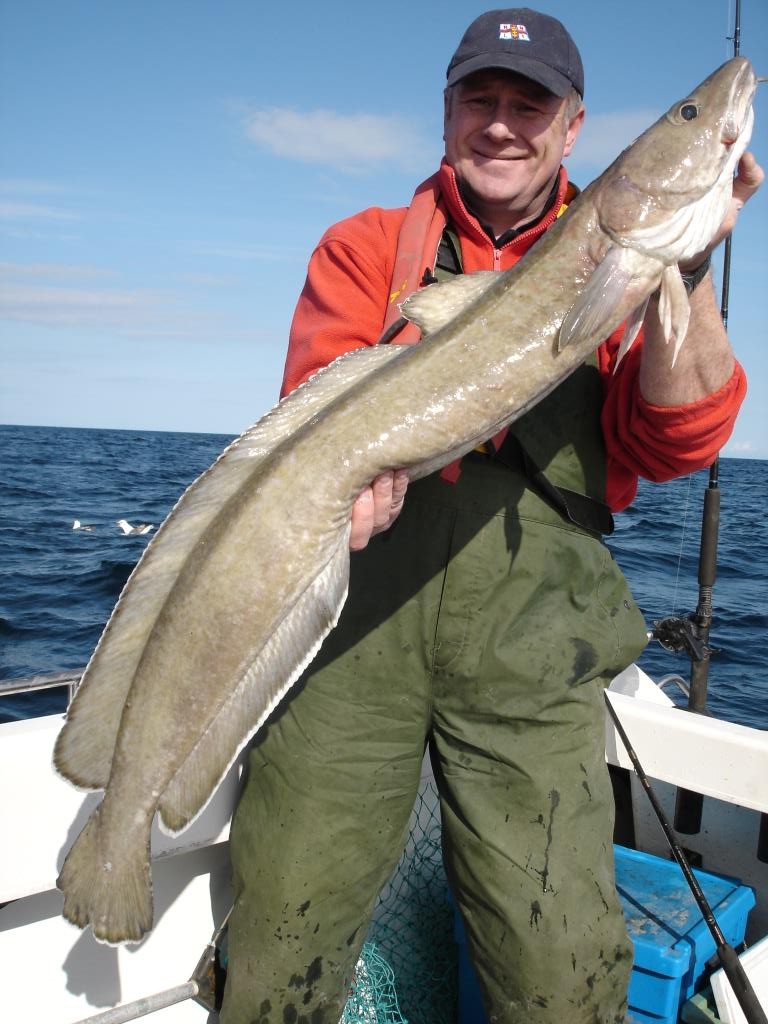* Pike: A New Season – Preparation Part 2

Key to achieving this is having a leader that allows you to confidently place pressure when fighting even the largest of Pike.
As the time for some decent fishing comes closer it is time to get the final preparations in order. You have the flies you have the rods and lines. The critical and oft overlooked component in your armoury is the connection betwixt hook and fly line – Leader. Ace pike angler Mark Houlihan guides you through the process of tying solid leaders that are up to the task.
The combination of synthetic flies and Double Hauling fast action rods loaded with Pike or saltwater tapered fly lines generate the line speeds required for fly anglers to fish lighter rod sizes for predatory fish. As I mostly fish synthetic patterns my personal choice is an 8 weight for the majority of my Pike and saltwater fly fishing. There is a balance between maximizing ones fishing pleasure and landing Pike in a responsible and timely manner. Key to achieving this is having a leader that allows you to confidently place pressure when fighting even the largest of Pike.
For me the most important aspects of a leader are its length, taper and material composition. If a leader is too long it won’t turn over the fly correctly, too short and the fly line shocks on both the back and forward stroke dissipating power required for proper fly presentation. I like a stiff leader material as this helps the turnover of larger flies.
The Leader
From fly line to fly my overall leader length is 2.3 meters and I use Rio Alloy Hard Saltwater Mono in equal 100cm lengths ( leaving 10 cm excess for knots) of 15 kg and 11.3 kg. The overall mono length is 2 meters. Rio Alloy Hard Mono has a high abrasive resistance for fishing around structure and is a lot more forgiving than fluorocarbon.
Landing Pike from a boat or float tube often requires the leader to pass through the rod guides. The connection between fly line and leader should be smooth allowing the leader to pass through the guides with little or no resistance protecting the rod tip from damage.

By nail knotting the leader directly to the fly line and coating with Loon Knot Sense, it creates a strong smooth reliable connection that will pass easily through the rod tip. Coating all of the leader knots with Loon Knot Sense allows the fly to be fished close to the rod tip. This has the advantage of fishing the fly for longer periods close to the boat where many takes occur. Perfect nail knots in less than 1 minute can be achieved by using a Tiefast tool and it’s also great for joining the leader material together with a nail knot splice.
The potential weak point of a pike leader is the connection between mono (fluorocarbon) and wire. Adding a tippet ring forms an insulated connection between both materials and allows the angler to put a lot of pressure when playing fish.
I prefer light supple wire as this allows flies to be fished with the desired action. I use 30 cm of 9 kgs Rio Bite Wire which is knot able, has a low diameter and extremely bite resistant.
To this I attach a lure clip. Some anglers don’t trust clips for good reason but I think it’s just a case of finding the right one.
Fastach clips in size 2 or larger size 3 have no moving parts to open while still providing good fly articulation.


Place a size 3 Fastach clip in a tying vice, attach a set of dumbbell eyes to create a jig mount for your non weighted patterns allowing flies to be fished deeper, adding a very effective “Clouser style” movement to most flies in your box.
This leader maximizes power transition from fly line to fly and also offers strength, convenience and versatility with quick fly change. I use the same leader set up for Bass replacing the wire with fluorocarbon.
Fine tuning your leader will maximize presentation while minimizing effort and allows for direct contact with the fly from the first pull of the retrieve. The quicker the fly can swim, the less reaction time predatory fish have and the possibility of more hook-ups. Since most modern mono core and braided fly lines have a breaking strain of less than 15 kgs its important to fish leaders with lighter breaking strains when fishing close to structure and snag filled bays where pike like to congregate. If the fly gets snagged, you want your leader to break and not your fly line!
As Winter officially comes to a close, water temperatures start to creep up and fish become more active and responsive to fly and lure. This is the best time of year when many of the very large female pike can be caught as they hunt and feed heavily on shoals of baitfish in anticipation of spawning. Hunting these fish can require a slightly different approach as low water temperatures affect pikes metabolism and often makes them reluctant to chase a fly. Fishing flies as slowly as possible and hanging them close to the boat or bank can be productive. Probably the most effective method at this time of year to produce quality and consistent results is using dead baits but that is not an option for many of us anglers that want to pursue these wonderful fish on the fly. So why not tie a fly that resembles a dead bait or dying fish?
Pike rely on an array of senses when hunting, eyesight, lateral line, inner ear and smell. Eyesight is of most importance to us fly anglers as tying flies to smell like baitfish isn’t really practical. Pike have excellent monocular vision with both eyes working independently of each other giving a 160 degree view either side of its body.
They also have shorter binocular vision which they use to target and strike a bait with great accuracy. Pike also have good overhead vision and the deeper the water, the wider the field of view. In early spring when pike are slow to move to a bait, its often necessary to offer them a fly that makes it worth their while to come from depths of 5-6 meters and chase. This time of the year large pike rarely expand the energy to hit small baits over these distances unless it’s going to be an easy meal such as a wobbled dead bait or a Stealth Fly.
I’ve been using Stealth flies the past 4 seasons with great affect and they can out fish any other method including dead baits.
This time of year I wouldn’t leave home without one!
The Stealth Fly
The Stealth Fly was designed by Greg Strelley of Pike Trek. (www.piketrek.com)
The Stealth Fly imitates a sick or dying fish as it glides through the water and the revolutionary tying process helps to achieve this. Apart from the tail section, all of the materials are tied at 90 degrees to the shank of the hook creating a flat profile 5 times larger than conventionally tied flies.
This fly is really light, easy to cast and the hook point is totally exposed leading to much better hook-ups.
How to fish:
The Stealth can be fished at any depth using any retrieve but probably the most effective method is using a floating line with little or no retrieve.
Just a gentle lift of the rod tip is enough to impart a lot of movement into the fly followed by a long pause.
This fly will catch pike in the most difficult of waters in bright conditions.
It can be tied in the colour combination of your choice and the materials are available from www.piketrek.com
I have fished this fly with great results over the past few seasons so tie some up and see the results for yourself.
[box]About the author: Mark Houlihan has been guiding anglers for many years both fresh and salt water. While fly fishing is his thing he is a lure angler of some repute. Mark mainly guides in the water around Cork but has been known to head further afield if the fishing dictates! You will read plenty from Mark here on TopFisher over the coming months and we look forward to superb action from the Lee Valley system, Marks home water. You can see more about Mark Houlihan here: www.flyfishireland.ie[/box]
Some video links:
Tying a Stealth Fly:
Video tutorial
Part 1
Part 2
Tiefast:


















